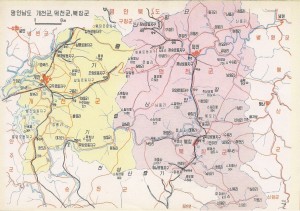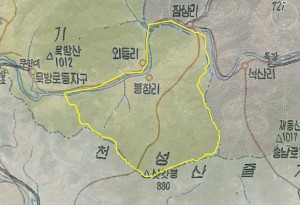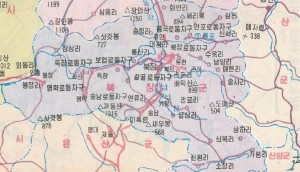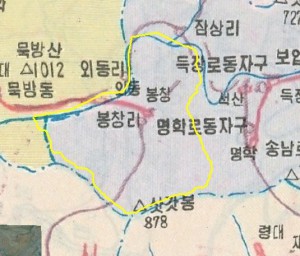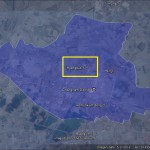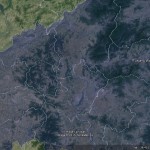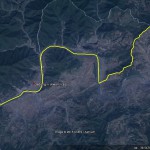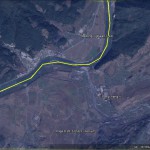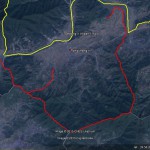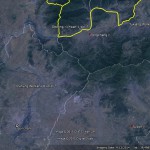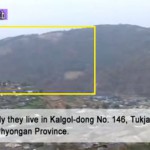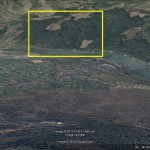UPDATE 2 (2015-9-24): For what it is worth, I do not believe much of Shin’s story (either of the three versions that have now been released). I believe he continues to deceive us on significant aspects of his history.
UPDATE 1 (2015-9-24): The latest version of Escape from Camp 14 has been released. Mr Harden has added a new forward to the book, but does not appear to have altered any of the passages in the text itself despite the fact that Shin has admitted that they contain inaccurate information. Since the book’s new forward references me, I thought I should post the information I provided Mr. Harden here for public scrutiny.
First of all, here are the maps of Kaechon and Pukchang that Mr. Harden references in the book’s new forward. This map was published in a North Korean atlas released in 1978:
This map shows that the area that came to be known as Camp 18, Pongchang-ri (봉창리), is clearly inside the borders of Kaechon County in 1978.
Here are the borders of Camp 18 overlapped on the map of 1978 Kaechon:
Because Pongchang-ri is inside Kaechon and is connected by rail to Camp 14, I stated that it is “plausible” that the area that came to be known as Camp 18 was actually part of Camp 14 in 1978.
According to the North Korean atlas Samchonri published by the Pyongyang Informatics Center, “in February 1984, Pongchang-ri of Kaechon County was incorporated into Pukchang County.” I told Mr. Harden that is was “plausible” that this is when Camp 18 was separated from Camp 14, since the two camps would now be housed in different counties. Shin claimed that Camp 18 was separated from Camp 14 in Kaechon sometime around 1980 for which I have no corroborating evidence.
Here is a North Korean atlas map of Pukchang published in 1997 which indicates that Pongchang-ri (봉창리, Camp 18) is part of Pukchang County:
And here is the same map with the border of Camp 18 outlined on it:
So North Korean sources indicate that the area that came to be known as Camp 18 was part of the same county as Camp 14 (Kaechon), until it was transferred to Pukchang in 1984.
ORIGINAL POST (2015-1-18): On October 26, 2014, Uriminzokkiri uploaded two videos to YouTube to discredit human rights activist Shin Dong-hyuk. Video one is here. Video two is here.
Below are some notes I took from the videos (back in October). I shared them with a couple of friends, but never published them. Point number 4 seems most relevant to the news this weekend, that Shin spent time in Camp 18.
1. Shin’s father, Shin Kyong-sop (신경섭?) claims he was born in Ryongbuk-ri, Mundok County: 룡북리, 39.498574°, 125.455410°. However, this ri was made part of Chongnam District. Chongnam District was initially carved out of Mundok County in 1980. In 1998 it was abolished and reincorporated into Mundok County. However, in 1999 Chongnam District was re-established with Ryongbuk-ri and Sin-ri of Mundok County. Either Shin’s father did not know that his home village had been moved into a new jurisdiction [because he has been incarcerated and not updated], or he is reporting that the ri was part of Mundok when he was born (it was). Ryongbuk-ri is appx 67km from Tukjang (as the crow flies), where Shin’s father lives now (according to the videos). More on Tukjang below.
2. The video asserts that Shin was born in 1980 (1:01, in video 1) and that his original name is Shin In-gun (신인근). Shin acknowledged this name, I am unsure about the birth year.
3. Shin claims he is from Oedong-ri (외동리, 39.575453°, 126.071407°) which is inside [officially unacknowledged] Camp 14. (1:37, Video 1). Camp boundaries in yellow.
4. Shin’s father claims that they did not live in a political prison camp [Camp 14] (1:52, Video 1), but in Pongchang-ri (봉창리, 39.562650°, 126.077345°). Pongchang-ri is on the opposite side of the Taedong River from Oedong-ri in Camp 14, where Shin claims he is from. Pongchang-ri became part of Pukchang County in February 1984. Before that, Pongchang-ri was officially part of Kaechon County (where Camp 14 is located).
However more importantly, Pongchang-ri is inside the former Camp 18. Shin’s father offers a photo he claims is of a six-year-old Shin in Pongchang-ri. The year would be 1986, but Camp 18 was not closed until the 2000s. So revealing that Shin lived in Pongchang-ri as a child is admitting he was in a prison camp (Camp 18)…just not the one he claims to have been from (Camp 14). So now the North Koreans and Shin can at least agree he was in Camp 18.
5. Dad says Shin went to primary school in Pongchang and secondary school in Tukjang (2:07, Video 1). But graduated from a different secondary school (“Suwon Secondary School”) and got a job in the “Suwon Pit”. [How common is it for North Korean schoolchildren to change secondary schools? Under what conditions does this happen?] Mr. Song Yoon-bok, chief secretary of “No Fence in North Korea,” has told me that the father did not say “Suwon” but rather “Suan,” and Uriminzokkiri misspelled it in English on the videos. “Suan” is a small area of eastern Pongchang-ri, and “Several former Camp 18 survivors now living in Seoul certainly remember the name and location…in Camp 18.” I cannot find this area on any maps, but a defector named Kim Hye-Suk identified it in this publication.
After the Suwon/Suan pit, Shin’s father claims he left home and moved to Puhung Mine in Unsan (2:53, Video 1). However when Shin was 12, (December 1992), Puhung Workers` District was incorporated into Sunchon City. It is still in Sunchon City. So his father is incorrect about the county/city that his son’s mine was in (unless Shin started working there before he was 12).
Shin’s father also says that most of Shin’s injuries come from mining accidents (3:23, Video 1). As of 2015-1-17, Shin still maintains his injuries are from torture.
Also, the father does not seem surprised when he is asked about family members being “raped to death” (4:05) [Like he does when he is asked about “reward Marriage”]. I believe that even most North Koreans would have a more visceral reaction to that question. Implies more coaching.
6. According to the video, Shin’s parents live in Kalgol-dong No. 146 of Tukjang Workers’ District. 39.577267°, 126.225550°. The North Korean video footage matches satellite imagery of Tukjang Workers’ District, but not of Kalgol-dong (3:20, Video 1). Tukjang Workers’ District lies just outside boundaries of former Camp 18.
7. The neighbor who discusses the alleged murder committed by Shin’s mother and brother seems to know about Shin’s “treasonous activities” in South Korea. How could she (or his father) have any idea what he is up to outside of the country unless they were coached? Also, the North Koreans are claiming that Shin’s mother and brother are guilty of axe murder! This is the second instance of axe murder in the DPRK of which I am aware (the first instance is quite famous). How many axe murders are there in the DPRK?
8. Shin’s father says he married his second wife in 1996 and Shin was 19 then (8:18, video 1). But if Shin was born in 1980, he should only be 16 (8:26, Video 1). The math on this is pretty easy, so the fact that he got it wrong implies it could have been fabricated. Shin’s father claims the newly-married couple lived with Shin for five years (8:40, Video 1), that would be from 1996 until 2001. Shin should be 16-21 years old during this period, but according to dad’s erroneous age he would be 19-24. This would mean that he moved to Puhung Mine when he was 21 (or 24 by fathers count).
When Shin’s father states that Shin was 19 when they were married, the mother-in-law nods her head in agreement (8:31, Video 1). At 8:40, however, there is a subtle cut in the video. The reason for the cut remains unknown (more coaching?). After the cut, Shin’s step-mother says that they lived with Shin for 3 years (1996-1999). She did not correct the age error. If Shin left their home in 1999, he would have moved to Puhung Mine in 1999 at the age of 19.
The manager at the Puhung Mine claims that Shin arrived in August 2002 (1:54, video 1), so there is a gap here of approximately one year by the father’s data and three years by the step-mother’s data. The mine manager describes Shin as “burly” (4:25). Not a description I would use.
9. The video claims Shin raped 13-year old at Puhung Mine (5:31) in June 2001 (5:45). Shin would be 21 then. This is over a year before he was employed at the Puhung Mine according to the manager. Why was he there? He should have still been living with his parents in Tukjang. Why was he never arrested or tried for the crime?
Other notes:
A. Shin’s uncle is in the video. Has Shin said anything about him?
B. Shin’s father was able to remarry a younger woman? 70 vs 56.
C. Shin’s father has a nice tv and radio. Is this really his home?
D. Finally: The DPRK previously tried to discredit Shin with this written statement. This written statement claims that Shin is from Soksan-ri (now part of Tukjang–the part that matches the video footage above). Soksan-ri is not ever mentioned in these videos by name, and it is not the same area of Tukjang as Kalgol-dong. There is also additional information on crimes committed by Shin’s father which are never address in the videos. This statement also mentions a first border crossing in 2002, after which Shin was sent back to the DPRK.
Hopefully Mr. Harden can get Mr. Shin to address some of these points in a revised publication.
Addendum: For the record, I have met Mr. Shin a couple of times at events in Washington. The extent of my interaction with him has been limited to a couple of handshakes. I have never emailed him, interviewed him, or had an extensive conversation with him.
